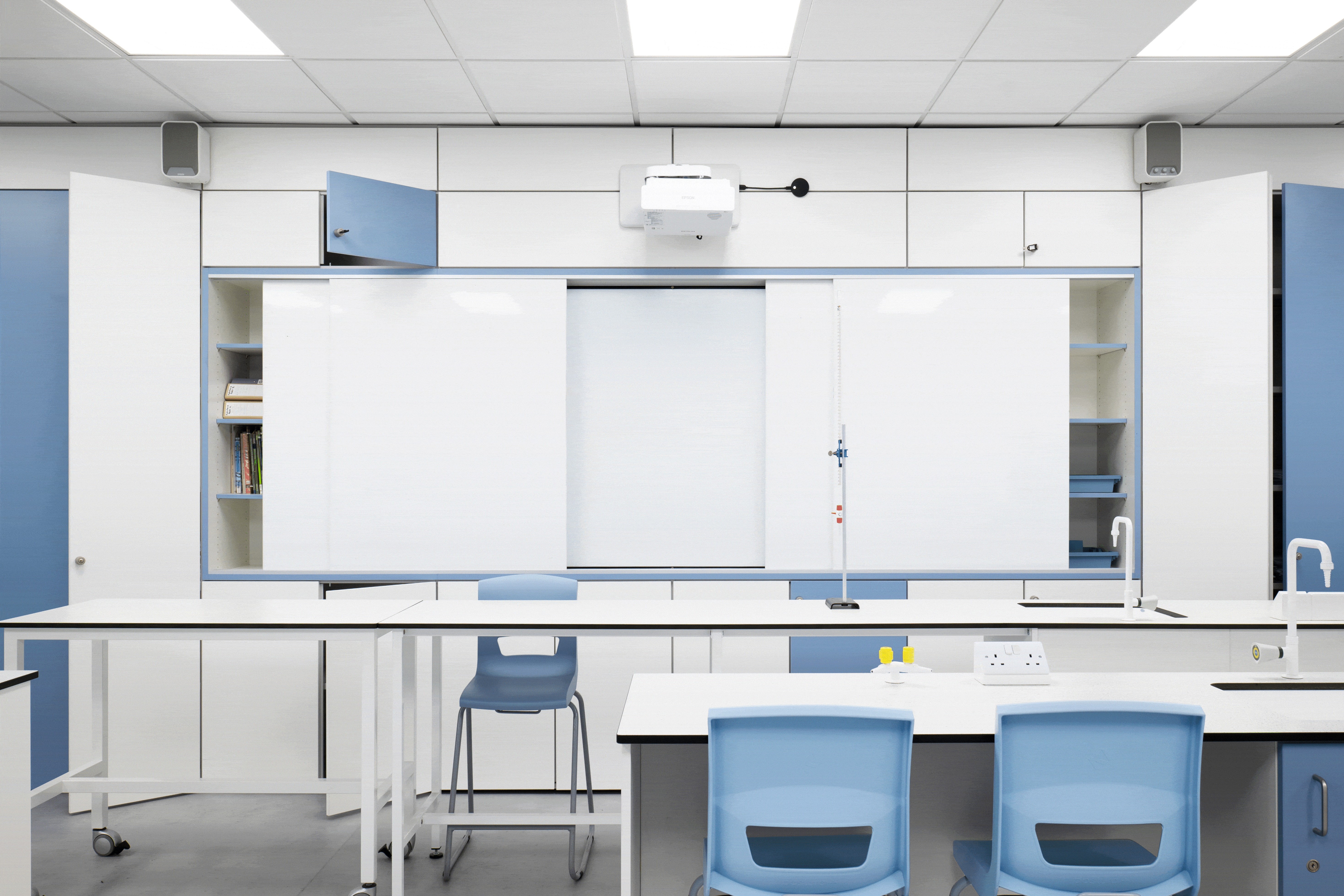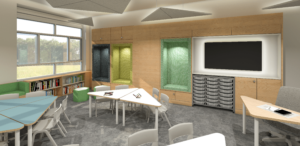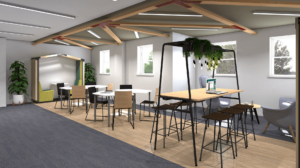Without technology a flexible learning environment would hardly be possible, therefore accommodating devices and connectivity within your space becomes of high importance.
Once your student device policy has been set out and established, you will need to ensure students are able to use their devices (both school-owned and personal) easily and efficiently. Establish ample easy-to-access charging points, along with data and wifi to enable seamless technology use.
Digital learning platforms, such as moodle help to enable students and teachers to share and view work, collaborate effectively and keep track of assignments.
Aside from personal devices, there may be times when students need to collaborate digitally on a larger screen, or present work to the class. Display and AV facilities that can be easily connected and put to use are great for enhancing lessons.
A Choice of Spaces:
Learning styles are as many and varied as personalities in the room, however there are a number of established learning zones that will accommodate a wide range of individuals working on an ever widening range of tasks. Individual High Focus Spaces allow students to really get their heads down to focus.A typical high focus working space would include both visual and acoustic protection, and is likely to be situated at a distance from the more collaborative spaces.
Individual Low Focus Spaces are individual workstations, but these may be situated in a busier area. These spaces are used for tasks that don’t require full in-depth concentration, and when the student is happy to be interrupted should a peer or teacher wish to engage with him.
Collaborative Spaces for larger groups are useful for group-based assignments, and often contain a large table as well as AV and display equipment. Writable surfaces and easily moved seats are helpful, as they allow students to brainstorm and move around the collaboration zone easily.
Collaborative spaces for smaller groups can be used for peer to peer discussions or working, as well as student to teacher interaction. Small booths such as the railway carriage or Nelson seat can help to create a small private zone, but are open enough to ensure sight lines and supervision is maintained.
Breakout spaces with soft seating are also useful within flexible learning environments as today’s generation are wired to working anywhere at anytime. There are some learning activities that may be suited to a more informal space, such as reading or conversing with peers.
Choosing Furniture and Finishes for your flexible learning environment:School environments take a regular battering so all furniture should first and foremost be durable enough for your space. We’re seeing a rise in the use of furniture with an additional purpose; from soft seating with integral device charging, to tables with writeable whiteboard surfaces. Doubling up furniture and facilities helps create a less cluttered environment.The furniture in a flexible learning environment should ideally be easy to move to enable easy reconfiguration of the space, should circumstances require. From foldable tables, to light stackable chairs, every item of furniture should be considered to ensure it is enjoyable and easy to use.Comfort and sustainability are big factors in the design of your space. Ensure furniture is ergonomically suited to the age of your students. Consider adjustable height tables so students can stand to work if they wish.There are a number of unique table shapes available to schools these days. By blending a range of shapes within your space you can increase student occupancy as well as creating a range of different learning zones.Learning spaces that enhance student wellbeing and mental health:Calming and uncluttered flexible learning environments have a large effect on student wellbeing. Recent studies have shown that the quality of the environment in which the students learn can impact results by up to 25% both positiviely and negatively.Opting for a user-centred design of your flexible learning environment will help empower students as well as giving you the best long term result from your space. Here at Envoplan we have tried and tested means for collecting user feedback through focus groups and feedback sessions.When students have a say in the design of your learning environment it also increases ownership and pride in the new space, minimalising vandalism and damage.Within a flexible learning environment, you will also need to consider which elements of the design are going to require individual resources or facilities, for example personal storage of bags and other lesson resources or device charging.
Empowering the Educator:
Research and feedback from schools that have implemented a more flexible learning environment report that teachers can sometimes feel isolated and unprepared for the new space. If you’re implementing flexible learning environments within your school, the teachers within your space must be prepared and ready to teach in this new environment.
A more open plan and flexible learning space requires teachers to have different skills to a traditional classroom. Ensuring students are cared for and up to date with their studies, as well as encouraging them to take responsibility for their own learning and to become more agentic is a different kind of teaching ability which comes with the blended learning style, and must be trained and developed before unleashing the new learning style and space. Old methods of teaching will not be ideally suited to a flexible learning environment!
Every school is unique:
The success of a new flexible learning environment within your school will lie with taking a personal approach to the project strategy. Every school is unique, therefore you must take account of the facilities you have, the role of the educators as well as the needs of the students.
The success of your project lies with your people. If your space has improved learning and results for both students and teachers then you will know it has been a success. If you are considering a new flexible learning environment within your school, implementing a change management team will be a wise move. Any new style of learning or new environment requires extensive training and on-boarding for staff and students alike. Ensure you achieve the best return on investment by managing the effect the new scheme has on your people. We would advise setting up a change management team to ensure your school’s unique needs are met. Change management teams provide a forum for user feedback, keep communication lines open and ensure the overall long-term success of your investment.Considering a new flexible learning environment?
Envoplan can help you with long term strategy as well as user-centred design and project implementation



